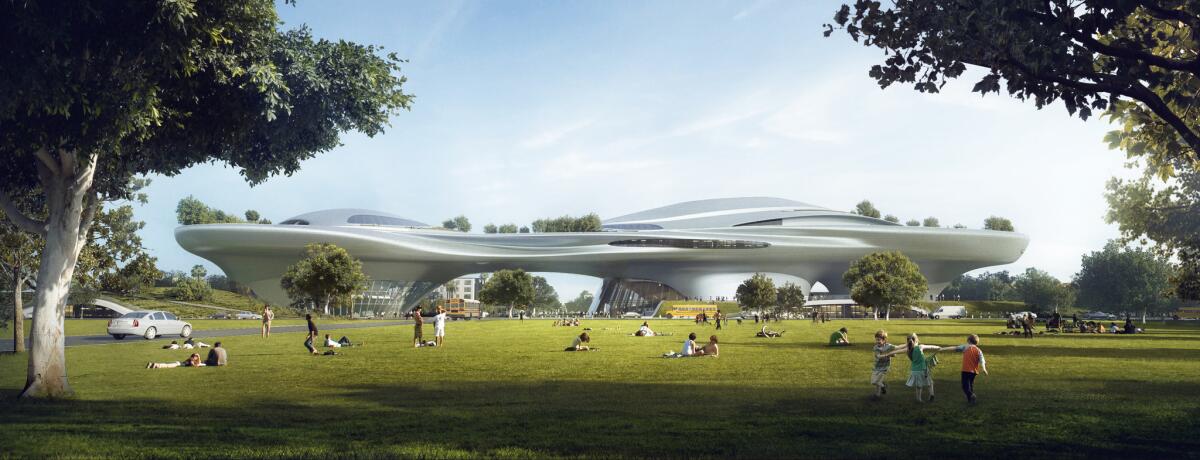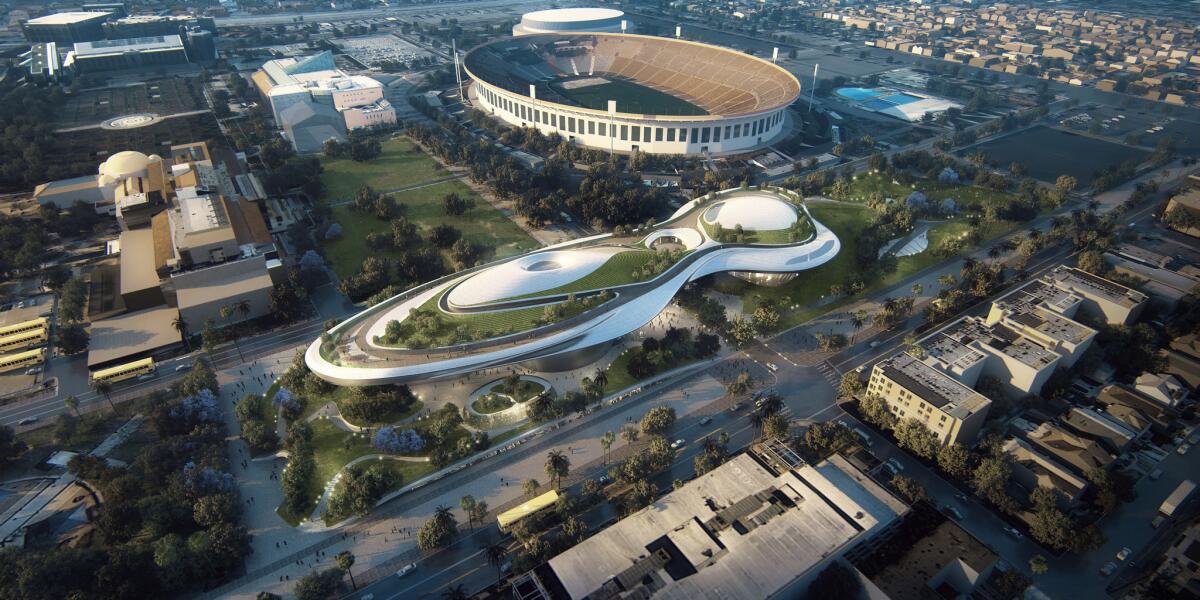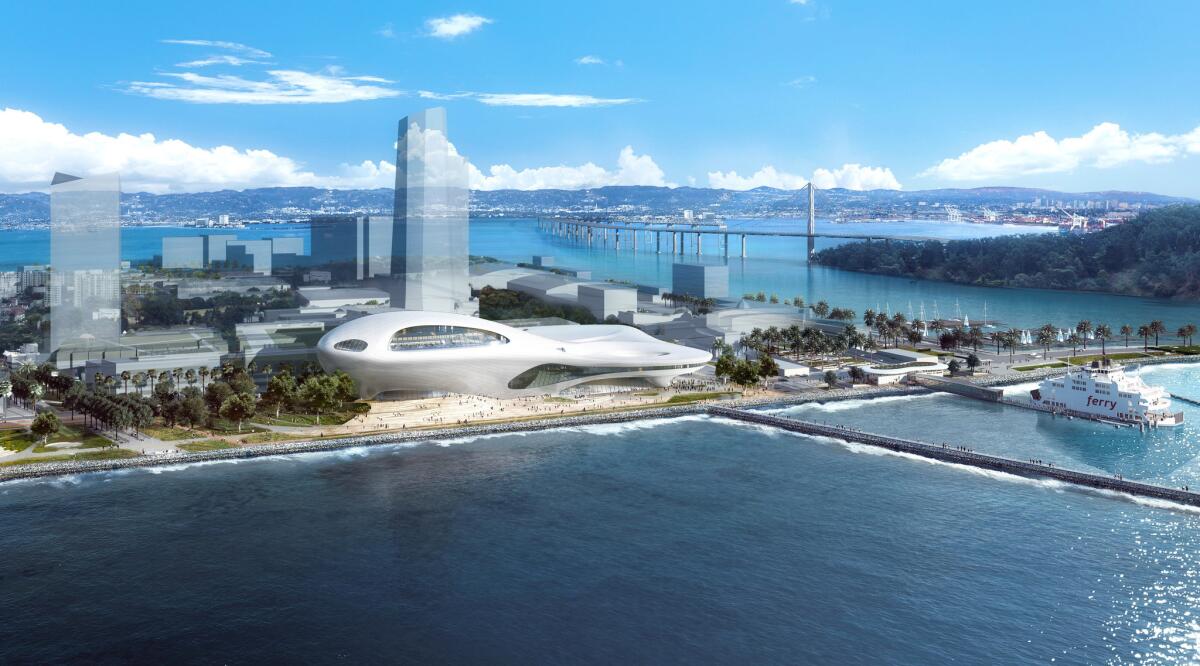George Lucas’ museum designs for L.A. and S.F.: A first look at competing plans
- Share via
George Lucas is hoping the third time will be the charm for his proposed Museum of Narrative Art, which has already been the victim of community opposition in San Francisco and Chicago.
Actually, that’s not quite right: Lucas is hoping that the third or the fourth time will be the charm. He’s decided to bundle those efforts together, simultaneously unveiling two different museum designs this week for a pair of California sites.
One proposal is for a location on Treasure Island, in San Francisco Bay. The other is in Exposition Park in Los Angeles, near the Natural History Museum and just west of the Coliseum. Both are fluid, forward-looking designs from the office of 40-year-old Chinese architect Ma Yansong, a rising star who also worked with Lucas on his ill-fated proposal for the Chicago lakefront.

Ma and the founding president of the museum, the polished and energetic art-world veteran Don Bacigalupi, met with me earlier this month in downtown L.A. and proceeded to give one of the more unusual presentations I’ve seen in my career as an architecture critic.
Propping an iPad Mini on the table, they began by flicking through renderings of the streamlined, all-white Exposition Park design. Then, barely skipping a beat, they called up a second series of images showing the Treasure Island proposal.
Call it hedging your bets, call it beefing up your odds, call it the architectural equivalent of quite publicly asking two people to prom on the same day: Lucas’ dual-track proposal is an unconventional strategy by any measure. And it suggests that rather than feeling chastened enough by those prior defeats to reassess his sales pitch, to slow down and rethink the plans for the museum in a wholesale way, Lucas is instead growing ever more impatient to get a deal done.
Even fellow billionaire Eli Broad, when he was scouting museum sites in 2009 and courting the cities of L.A., Beverly Hills and Santa Monica, didn’t announce his choice of architect — to say nothing of releasing a design — before he’d settled on a location.

The Los Angeles site occupies a narrow strip of land along Vermont Avenue, in a section of Exposition Park now filled by a pair of surface parking lots. (Not to worry, traffic-obsessed Angelenos: The proposal calls for a subterranean parking structure for 1,800 cars.) The museum would rise just south of Jesse Brewer Jr. Park and a light-rail stop on Metro’s Expo Line.
Forming a kind of gateway facing 39th Street along the western edge of the park, the building would hold between 265,000 and 275,000 square feet of interior space, with about 100,000 square feet earmarked for galleries. The dimensions of the Treasure Island museum are the same.
Lucas and Bacigalupi have already done much of the political heavy lifting for the new proposals, securing the backing of L.A. Mayor Eric Garcetti and Mayor Ed Lee in San Francisco, which has jurisdiction over Treasure Island.
Garcetti called me — unsolicited — earlier this week to express his strong support for putting the museum in Exposition Park, a short walk from USC’s Mediterranean-style School of Cinematic Arts, which Lucas helped to fund as well as design. Garcetti said the populist bent of the museum’s collection, along with its connections to Hollywood history, made it a natural fit for a site that’s in the geographical center of the city, adjacent to light rail and near museums and public-school campuses.
But persuading politicians to offer him public land in prime locations has never been Lucas’ problem. Elected officials tend to find irresistible the idea that he is willing to pay for the construction of a museum that is likely to draw big crowds of locals and tourists alike — and fund an endowment to the tune of at least $400 million. What he’s struggled with is winning over the civic groups that have some control over these patches of parkland. Not to mention skeptical members of the media.
The L.A. proposal has clear similarities to Peter Zumthor’s controversial design for a new building to hold the permanent collection of the Los Angeles County Museum of Art. Both designs call for galleries laid out horizontally but lifted above ground level, allowing pedestrians to flow underneath. And both remain rather fuzzy when it comes to interior details.
Ma’s design sets aside a significant amount of shaded landscaping under the museum building, where parked cars now sit, allowing Bacigalupi to argue that rather than removing green space from Exposition Park, they would in fact be adding some. And unlike Zumthor’s building for LACMA, Ma’s Exposition Park proposal is topped by thickly planted and publicly accessible terraces.
Still, the proposal would squeeze a very large new building into a park already crowded with attractions.

On Treasure Island, the museum would be part of a new master-planned district facing the San Francisco skyline and near a proposed ferry terminal. (Virtually all visitors now reach the island via the San Francisco-Oakland Bay Bridge.) The site offers dramatic views of the Bay but is buffeted by strong winds; in response, Ma’s design has less outdoor space and significantly larger bands of windows than the L.A. version.
Both proposals feature the smooth, digitally derived forms for which Ma (who is also designing a mixed-use project on Wilshire Boulevard in Beverly Hills) is well known. Bacigalupi said it was too early to say exactly how much the museum might cost to build in either location. (Including the endowment, the total value of the project is likely to exceed $1 billion.) He also said details of a lease agreement at either spot remained to be hammered out.
The double release of the conceptual designs is just the latest twist in a campaign that has been unorthodox, even scattershot, from the start. When Lucas first went public with plans for a San Francisco museum to hold his collection, which is heavy on Norman Rockwell and Hollywood artifacts and largely disdains modernism, minimalism and abstraction, neither Bacigalupi nor Ma was part of his team.
He worked instead with Dallas architecture firm Urban Design Group to produce a design near Crissy Field — for an institution then known as the Lucas Cultural Arts Museum — that was nostalgic and generally conservative, much like the art Lucas favors. After that plan was rejected, he turned his attention to Chicago in early 2014 — and made some dramatic changes.
He hired Bacigalupi (former director of the Crystal Bridges Museum of American Art in Arkansas, the San Diego Museum of Art and the Toledo Museum of Art). He renamed the museum, suggesting with the use of the word “narrative” that it would be an institution dedicated to exploring how filmmakers and artists alike rely on various storytelling traditions. And he unveiled a giant, mountain-shaped design by Ma for which Chicago Mayor Rahm Emanuel became a forceful advocate.
Different city, different architect, same result: The Chicago proposal became as politically toxic as the San Francisco one had been, with the group Friends of the Parks taking the place of the Presidio Trust as the sharpest thorn in Lucas’ side. He finally threw in the towel — or tossed it into the lake — in June.
And so back to California. Bacigalupi and Ma, for Rounds 3 and 4 of the Lucas sweepstakes, have refined both their pitch for what the museum will look like and the issue of what precisely it will hold.
SIGN UP for the free Essential Arts & Culture newsletter »
Over the summer, Lucas invited Charles Desmarais, art critic at the San Francisco Chronicle, to visit him in Marin County and take a detailed look at the collection. Desmarais came back convinced, writing that work by Rockwell, N.C. Wyeth, Jacob Lawrence, R. Crumb and others, not to mention costumes and other objects from “Star Wars,” “The Ten Commandments” and other films, “may just be the core of a great museum.”
Even if that turns out to be the case, there is still the matter of a clash at both sites between the collection and its container, between art and architecture.
If any of Ma’s sculptural, dramatically abstract proposals for the museum — and there have now been three of them, for Los Angeles, Treasure Island and Chicago — were a work of art, there is little chance Lucas would be interested in adding it to his collection. In my experience, when the architecture of a proposed museum is noticeably out of step with the collection it is meant to hold, it’s usually a sign of larger, hidden power struggles or a tangled sense of mission. Or both.
Some of Lucas’ supporters have made the case that the museum’s futuristic gleam is reminiscent of the inventive look of the early “Star Wars” movies. But that seems a stretch, a desire to see a link between Lucas’ youthful Hollywood work and his current architectural thinking that may not actually be there.
A bigger question is simply whether the collection and building are strong enough as cultural attractions to justify handing over public land to a wealthy patron making an aggressive sales pitch. It is too early to make any final judgment on that score, especially as Ma’s design for the galleries and other sections of the museum interior remains largely preliminary.
Garcetti said he would be surprised if the Los Angeles proposal generated significant opposition, from the Exposition Park board or other groups. Conversations with neighborhood council leaders and officials at the nearby museums and at USC have convinced him, he added, that the plan will get a very warm welcome.
Lucas is likely to choose a location for the museum early next year.
Twitter: @HawthorneLAT
ALSO
Downtown L.A.’s new U.S. courthouse, a glass cube that seems to float in mid-air
The battle of the ballparks: Cubs vs. Dodgers and the lost history of L.A.'s own Wrigley Field
D.C.'s new African American museum is a bold challenge to traditional Washington architecture
UPDATES:
Oct. 28, 11:22 a.m.: This article was updated to incorporate more details from interviews with museum and design officials.
3:47 p.m.: This article was revised for language and length.
The biggest entertainment stories
Get our big stories about Hollywood, film, television, music, arts, culture and more right in your inbox as soon as they publish.
You may occasionally receive promotional content from the Los Angeles Times.








